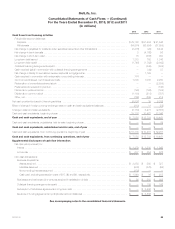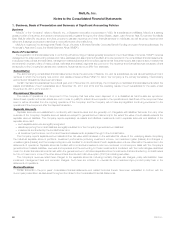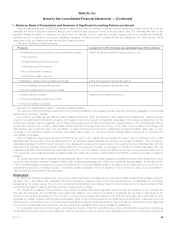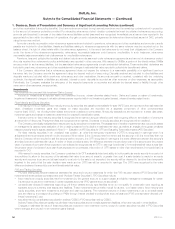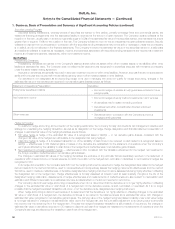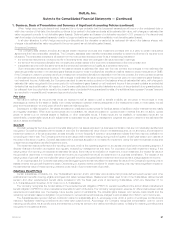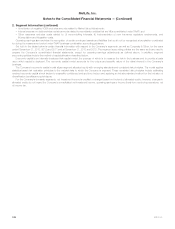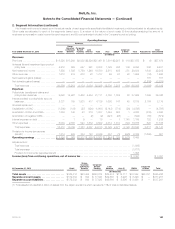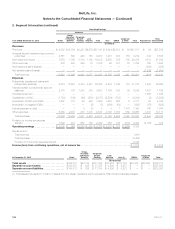MetLife 2013 Annual Report Download - page 107
Download and view the complete annual report
Please find page 107 of the 2013 MetLife annual report below. You can navigate through the pages in the report by either clicking on the pages listed below, or by using the keyword search tool below to find specific information within the annual report.
MetLife, Inc.
Notes to the Consolidated Financial Statements — (Continued)
1. Business, Basis of Presentation and Summary of Significant Accounting Policies (continued)
costs are amortized generally over a four-year period using the straight-line method. The cost basis of computer software was $1.7 billion and
$1.5 billion at December 31, 2013 and 2012, respectively. Accumulated amortization of capitalized software was $1.1 billion and $932 million at
December 31, 2013 and 2012, respectively. Related amortization expense was $216 million, $221 million and $217 million for the years ended
December 31, 2013, 2012 and 2011, respectively.
Other Revenues
Other revenues include, in addition to items described elsewhere herein, advisory fees, broker-dealer commissions and fees, administrative
service fees, and changes in account value relating to corporate-owned life insurance (“COLI”). Such fees and commissions are recognized in the
period in which services are performed. Under certain COLI contracts, if the Company reports certain unlikely adverse results in its financial
statements, withdrawals would not be immediately available and would be subject to market value adjustment, which could result in a reduction of the
account value.
Policyholder Dividends
Policyholder dividends are approved annually by the insurance subsidiaries’ boards of directors. The aggregate amount of policyholder dividends
is related to actual interest, mortality, morbidity and expense experience for the year, as well as management’s judgment as to the appropriate level of
statutory surplus to be retained by the insurance subsidiaries.
Foreign Currency
Assets, liabilities and operations of foreign affiliates and subsidiaries are recorded based on the functional currency of each entity. The
determination of the functional currency is made based on the appropriate economic and management indicators. With the exception of certain
foreign operations, primarily Japan, where multiple functional currencies exist, the local currencies of foreign operations are the functional currencies.
Assets and liabilities of foreign affiliates and subsidiaries are translated from the functional currency to U.S. dollars at the exchange rates in effect at
each year-end and income and expense accounts are translated at the average exchange rates during the year. The resulting translation adjustments
are charged or credited directly to OCI, net of applicable taxes. Gains and losses from foreign currency transactions, including the effect of re-
measurement of monetary assets and liabilities to the appropriate functional currency, are reported as part of net investment gains (losses) in the
period in which they occur.
Earnings Per Common Share
Basic earnings per common share are computed based on the weighted average number of common shares, or their equivalent, outstanding
during the period. The difference between the number of shares assumed issued and number of shares assumed purchased represents the dilutive
shares. Diluted earnings per common share include the dilutive effect of the assumed: (i) exercise or issuance of stock-based awards using the
treasury stock method; (ii) settlement of stock purchase contracts underlying common equity units using the treasury stock method; and
(iii) settlement of accelerated common stock repurchase contracts. Under the treasury stock method, exercise or issuance of stock-based awards
and settlement of the stock purchase contracts underlying common equity units is assumed to occur with the proceeds used to purchase common
stock at the average market price for the period.
Adoption of New Accounting Pronouncements
Effective July 17, 2013, the Company adopted new guidance regarding derivatives that permits the Fed Funds Effective Swap Rate (or Overnight
Index Swap Rate) to be used as a U.S. benchmark interest rate for hedge accounting purposes, in addition to the United States Treasury and London
Interbank Offered Rate (“LIBOR”). Also, this new guidance removes the restriction on using different benchmark rates for similar hedges. The new
guidance did not have a material impact on the financial statements upon adoption, but may impact the selection of benchmark interest rates for
hedging relationships in the future.
Effective January 1, 2013, the Company adopted new guidance regarding comprehensive income that requires an entity to provide information
about the amounts reclassified out of AOCI by component. In addition, an entity is required to present, either on the face of the statement where net
income is presented or in the notes, significant amounts reclassified out of AOCI by the respective line items of net income but only if the amount
reclassified is required under GAAP to be reclassified to net income in its entirety in the same reporting period. For other amounts that are not required
under GAAP to be reclassified in their entirety to net income, an entity is required to cross-reference to other disclosures required under GAAP that
provide additional detail about those amounts. The adoption was prospectively applied and resulted in additional disclosures in Note 16.
Effective January 1, 2013, the Company adopted new guidance regarding balance sheet offsetting disclosures which requires an entity to disclose
information about offsetting and related arrangements for derivatives, including bifurcated embedded derivatives, repurchase and reverse repurchase
agreements, and securities borrowing and lending transactions, to enable users of its financial statements to understand the effects of those
arrangements on its financial position. Entities are required to disclose both gross information and net information about both instruments and
transactions eligible for offset in the statement of financial position and instruments and transactions subject to an agreement similar to a master netting
arrangement. The adoption was retrospectively applied and resulted in additional disclosures related to derivatives in Note 9.
On January 1, 2012, the Company adopted new guidance regarding accounting for DAC, which was retrospectively applied. The guidance
specifies that only costs related directly to successful acquisition of new or renewal contracts can be capitalized as DAC; all other acquisition-related
costs must be expensed as incurred. Under the new guidance, advertising costs may only be included in DAC if the capitalization criteria in the direct-
response advertising guidance in Subtopic 340-20, Other Assets and Deferred Costs — Capitalized Advertising Costs, are met. As a result, certain
direct marketing, sales manager compensation and administrative costs previously capitalized by the Company will no longer be deferred.
On January 1, 2012, the Company adopted new guidance regarding comprehensive income, which was retrospectively applied, that provides
companies with the option to present the total of comprehensive income, components of net income, and the components of OCI either in a single
continuous statement of comprehensive income or in two separate but consecutive statements in annual financial statements. The standard eliminates
the option to present components of OCI as part of the statement of changes in stockholders’ equity. The Company adopted the two-statement
approach for annual financial statements.
Effective January 1, 2012, the Company adopted new guidance on goodwill impairment testing that simplifies how an entity tests goodwill for
impairment. This new guidance allows an entity to first assess qualitative factors to determine whether it is more likely than not that the fair value ofa
MetLife, Inc. 99


